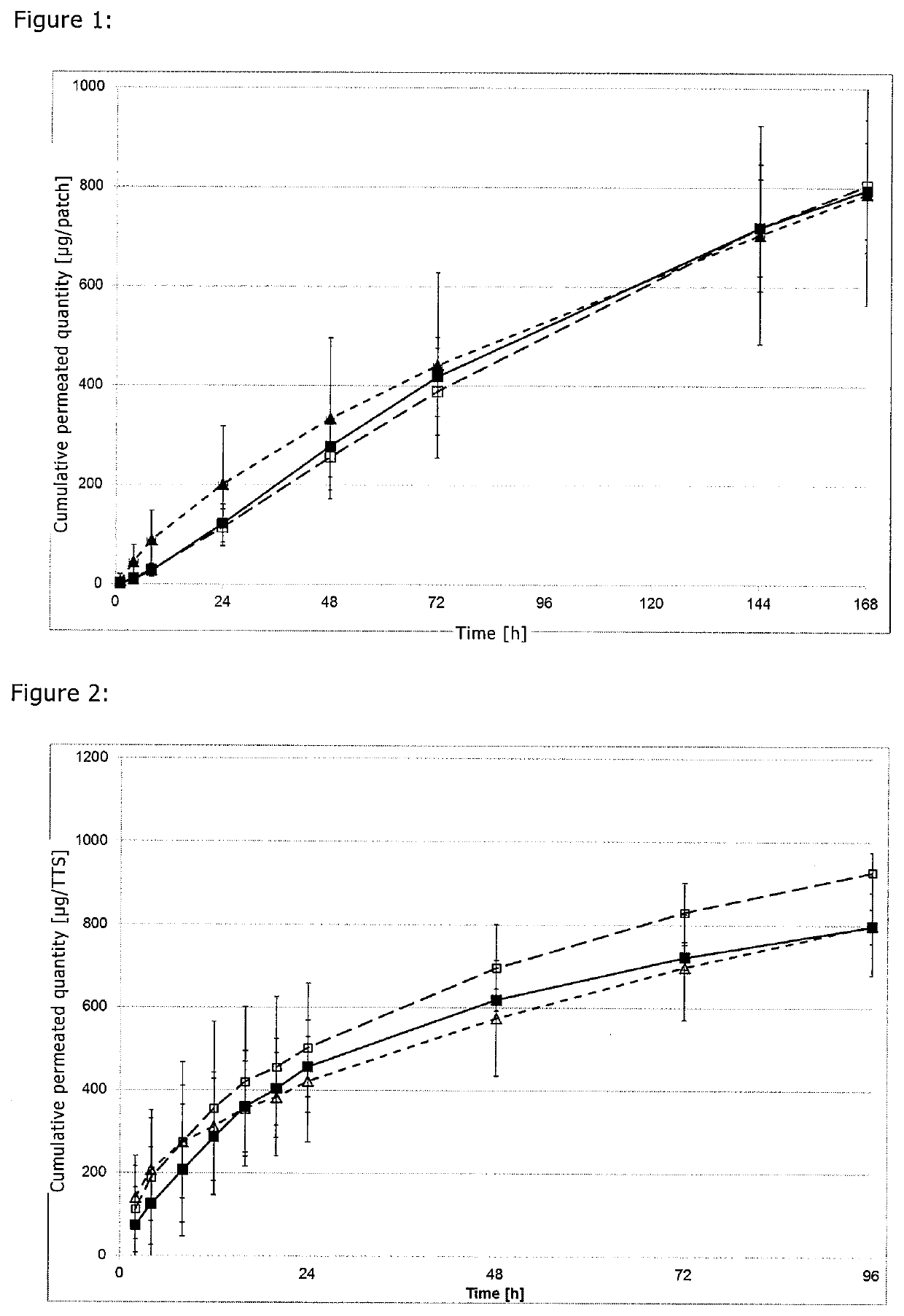Transdermal therapeutic system for dispensing scopolamine without a membrane
a technology of transdermal therapeutic system and scopolamine, which is applied in the direction of digestive system, sheet delivery, heterocyclic compound active ingredients, etc., can solve the problems of clothing or hands being dirtied with “toxic” substances, increasing production costs, and relatively high time expenditure for the production of corresponding application systems
- Summary
- Abstract
- Description
- Claims
- Application Information
AI Technical Summary
Benefits of technology
Problems solved by technology
Method used
Image
Examples
example 1
Production of the Reservoir Layer
[0047]To produce the reservoir layer, 13.78% of scopolamine base, 3% of oleic acid, and 83.22% of Bio-PSA 4301 (60% of polymer solid in heptane) were formulated as a suspension. The suspension was applied by doctor blade to a fluoropolymer-coated polyester film and was dried for 30 min at 40° C. The coating weight of the dried film was 90 g / m2. The dried film was then covered with a 19 μm thick polyester film.
Production of the Skin Contact Layer
[0048]To produce the skin contact layer, 3% of scopolamine base, 3% of oleic acid, and 94% of Bio-PSA 4301 were formulated as a solution. The solution was applied by doctor blade to a fluoropolymer-coated polyester film and was dried for 15 min at 40° C. The coating weight of the dried film was 40 g / m2. The dried film was then laminated with the laminate of reservoir layer / polyester film, from which the fluoropolymer-coated film was removed beforehand.
[0049]This resulted in an active substance-containing lamin...
example 2
[0051]The production was performed similarly to Example 1, with the skin contact layer being formulated with a proportion of 1.2% scopolamine, 3% oleic acid, and 95.8% Bio-PSA 4301, and the reservoir layer being formulated with a proportion of 16.25% scopolamine, 3% oleic acid, and 80.75% Bio-PSA 4301. The skin contact layer was produced with a weight per unit area of 50 g / m2 and the reservoir layer was produced with a weight per unit area of 80 g / m2.
example 3
Production of the Reservoir Layer
[0052]To produce the reservoir layer, 10.4% of scopolamine base, 8% of Transcutol, 1.1% ethyl cellulose, 2% BrijL4, and 78.5% Bio-PSA 4201 were formulated as a dispersion. The dispersion was applied by doctor blade to a fluoropolymer-coated polyester film and was dried for 11 min at room temperature. The coating weight of the dried film was 100 g / m2. The dried film was then covered with a 19 μm thick polyester film.
Production of the Skin Contact Layer
[0053]To produce the skin contact layer, 10% of scopolamine base, 7.7% of Transcutol, 1% ethyl cellulose, 2% BrijL4, 10.6% silicone oil, and 68.7% Bio-PSA 4201 were formulated as a dispersion. The dispersion was applied by doctor blade to a fluoropolymer-coated polyester film and was dried for 4 min at room temperature. The coating weight of the dried film was 40 g / m2. The dried film was then laminated with the laminate of reservoir layer / polyester film, from which the fluoropolymerised film was removed ...
PUM
| Property | Measurement | Unit |
|---|---|---|
| Time | aaaaa | aaaaa |
| Time | aaaaa | aaaaa |
| Mass | aaaaa | aaaaa |
Abstract
Description
Claims
Application Information
 Login to View More
Login to View More - R&D
- Intellectual Property
- Life Sciences
- Materials
- Tech Scout
- Unparalleled Data Quality
- Higher Quality Content
- 60% Fewer Hallucinations
Browse by: Latest US Patents, China's latest patents, Technical Efficacy Thesaurus, Application Domain, Technology Topic, Popular Technical Reports.
© 2025 PatSnap. All rights reserved.Legal|Privacy policy|Modern Slavery Act Transparency Statement|Sitemap|About US| Contact US: help@patsnap.com

